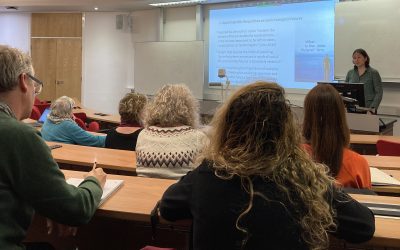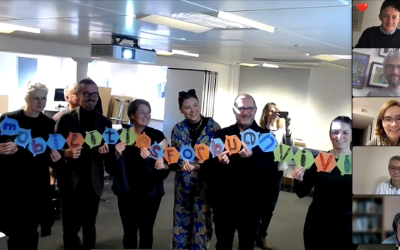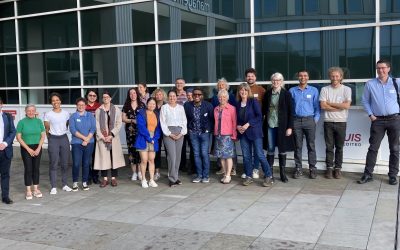I have recently returned from a wonderful month in Lancaster and surrounds. I embraced my mobility, visiting the Lakes District, Glasgow, London, Manchester, Keele University near Crewe, and of course, the local worlds of Lancaster.
I used buses, trains, and mostly walked. I felt on the move in more ways than one; it was being in motion that kept me upright on the other side of the world, as I worked hard to make the most of a precious time away to work, having left family at home. In the Lakes District, I decided, after much deliberation, to head to Grasmere for a day and visit Dove Cottage. The visit became an emblem of all that would follow, because here I took full advantage of my tourist status to wander into a world of ideas, chance encounters, opening my mind to a longer history of mobility. William Wordsworth and his sister Dorothy both wrote, as I now see clearly, about so many of the wanderers who passed their door – or people who they encountered on the road. Having just embarked on a new way inside my historical writing about mobility through vagrancy, as I explain more below, I found this really interesting: those who walked, wandered, travelled, passed through, became contact points for the observation of poverty, the wayfarer, the outsider, or the person whose life reminded these writers of other lives. That Dove cottage became a hub for creative people, writers and others, means that it too became a kind of station or stopping point for those moving in search of a place to think, write and interact. As my own movement through places engaged me and set of all sorts of ideas about how to think about mobility, I began to revel in my being away and in the opportunity afforded to me – the very mobility of an academic and intellectual life.
Being mobile as a visiting academic is an absolute privilege. The long haul flight is worth it – because meeting people in person then enhances our sense of ongoing connections, conversations and fruitful research exchanges. But before I thank CeMoRe and my hosts in this first blog, I want to briefly report on my aims for the fellowship.
As part of my CeMoRe Visiting Fellowship I was asked to contribute two blog posts. It’s an absolute pleasure to reflect on my busy month based at Lancaster in CeMoRe. In recent years – since around 2010 – I have been developing my work about the histories of the institutionalised insane in the colonial world of Australia and New Zealand to reflect and engage with the ‘mobilities turn’. In part because the historical scholarship that has captivated my attention has been focused on this question of ‘mobility’, but also because a recent large research project, externally funded by New Zealand’s Marsden Fund (Royal Society of New Zealand) has focused on immigration and mental health, the concept of mobility has been exciting and productive. As a CeMoRe Visiting Fellow I was able to discuss this recent work of historical scholarship and show how a new project to examine the history of vagrancy in the colonial world of New Zealand has grown out of my interest in social institutions, regulation, law and the fate of mobile peoples in the colonies.
This notion of ‘regulation’ of mobility needs to be teased out some more. What exactly were colonial and imperial authorities worried about, and why did they need to regulate the movement of some? I argued in my CeMoRe paper that social institutions – such as the insane asylum – became ‘transfer points’, sites for the immobilized to keep the problem of mobility and circulation of persons in view. This was an argument that drew from work by John Urry, Tom Cresswell and others. But increasingly, although I know these arguments work for the study I have just completed, I want to engage with new ways of seeing, reading, interpreting and understanding ‘vagrancy’ through a much more supple, fluid and mobile analysis. To this end, my reading, thinking, conversations and focus in Lancaster were centred on this problem of becoming more flexible in my thinking and analysis. Even though I consider myself a ‘poststructuralist’ historian, given my interest in linguistic constructions, I realise that I operate inside structures – especially given my work on institutions. The challenge, then, is to find ways to move outside and beyond these through a new way of thinking about mobility as the lens on the past, adopting a different set of ways to look at and ‘see’ the past.
I will explore the findings of this insight in my next blog entry. For now, I want to comment that the other helpful and liberating aspect of this fellowship has been the connections I have made or re-made with parts of my scholarly self. I was officially hosted by Professor Lynne Pearce, from the English Department at Lancaster, who is working on auto-mobility at the moment. Through Lynne I found accommodation with another English literature academic, and also met creative writing and literature academics. This reminded me of my former academic loves in writing, literature and literary expression. Taking us back to poetry, to Wordsworth and company, this characterised my thinking about bringing the ‘mobilities turn’ home to some of my Humanities colleagues. To that end, at the “>Sixth Mobilities Network Symposium that we are hosting in June at the University of Waikato, I plan to talk about Jim Crace’s novel Harvest. I wanted to explore some other ways of finding historical mobility through imaginative ways inside the world of the past. The title of this paper will be: ‘The disruptive mobility of the ‘vagrant’ in Harvest, by Jim Crace (2013)’.
My next blog will talk in more detail about my new project and the ways I am rethinking my approach as a result of the CeMoRe Fellowship.
Thanks:
My time at CeMoRe was really critical at this juncture in my development as a scholar, and especially for my thinking about mobilities research as I move into new projects and fresh thinking. The interdisciplinary environment is very important to help extend and to challenge scholarship across boundaries. I’d like to sincerely thank the CeMoRe staff for their support, and in particular, for the financial support to enable me to visit the Centre. Thanks go to Pennie Drinkhall, John Urry, Monika Buscher, Colin Pooley, and a good many other people for their company, conversations and assistance, and for the very warm welcome to Lancaster. Special thanks to Prof Lynne Pearce for her kindness, thoughtfulness, super organising of our half-day event and to the four speakers. Lynne was a terrific host and we can see possible future collaborations stemming from this time. I’d love to return!




